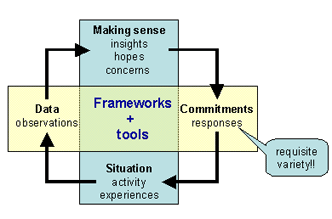![]()
----------------
See also...
Many forms of data - many uses
Data are one way of representing aspects of reality. To be meaningful they must be based on some underlying concepts, such as performance, significance, relevance...
Data, knowledge, actions, arrangements, relationships and time
Data are historic - based on observations of the past or present (which immediately becomes the past)
Data only become data in relation to the need to know (knowledge)
Knowledge and actions, arrangements and relationships are continually constructed and reconstructed in the present (mostly in conversations) as we make sense of our (shared) activity and experience. Knowledge only becomes knowledge in relation to the need to act (action). In the diagram below time flows clockwise:
Actions are responses made in the present with a view to the future.
Sense making
The following diagram suggests three zones of knowledge work:
- situational: being aware of activity and experience in the situation
- information processing: working with data and introduced information using tools and frameworks such as policies, regulations... and formulating responses that will address the hopes, concerns and constraints in the situation
- sense making: identifying gaps, patterns, connections between and
within the information in order to gain insights into the situation and to clarify one's hopes and
concerns (motivations for action/inaction) in relation to
- responding to the situation with the requisite variety of responses*
- better managing the information processing** (improved tools and frameworks?)
- how to be more aware of activity and experience in the situation

Notes:
* Unacceptable actions and experiences usually require urgent and direct attention and present us with challenges in relation to our capacity to make a successful and acceptable response: Do we have the requisite variety of responses?. There are two ways to address this issue over time:
- increase the variety of one's available responses (eg, through professional learning)
- reduce the need for a wide range of responses (school / community development)
** Information processing can be improved by processing the 'right information'. For example, based on insights into how most students' behaviour improves over time, monitoring progress in a student's behaviour usually involves answering three information questions:
- Are the incidents getting less frequent (further apart)?
- Is the recovery time after an incident getting shorter?
- Are the incidents becoming less severe?
Data can be
- a description, eg, of an incident
- a summary, eg, of progress through a program
- a measure using
- an agreed scale, eg, of confidence or concern
- a unit of measure, eg, age
- a relative placement, eg, percentile
- a code, eg, for a class, year group or incident type
- a flag symbol, eg, indicating a status such as 'completed'
- a goal to be achieved
- a statement of intention (to act)
- ...
The Support Planner can help users to manage most of these forms of data
Data categories
It may be useful to think in terms of three categories of data
- Input data such as incident details, needs, capabilities, trends
- In-process data such as who is doing what and when, that is, support actions
- Output data such as trends, progress such as fewer incidents, faster recovery, less severe
A key question
How will you use the data? There are two main possibilities
- record keeping (*definitely not recommended !!)
- as an index of those things that are significant (highly recommended)
*People sometimes try to put everything into a database but this can be very costly in time and energy, and it tends to produce something that is cumbersome and difficult to manage, maintain and use.
Cost:benefit analysis
The cost is mainly time and energy involved in gathering, entering and working with the data. Transferring the data from other records is rework and waste!!
The benefit comes from extracting the data in a way that informs action in a timely fashion.
The aim is to have an information system with minimum data which can easily produce key information.
Central questions for users
- How will this initiative complement what is already in place?
- What will become redundant (savings here)
- What will become possible? At what cost?
- How can the use of the database be integrated into our ongoing practice?
- Who will own it? And ensure its use, maintenance...
- ...
Quality of data
Data is never perfect. The quality of data reduces
- over time - it becomes less complete, less timely, less accurate
- if not related to other data and to human experience
- if not used it is not updated and its validity becomes less certain
The quality of data is improved by its use!! The more widely it is used (different people, purposes, contexts...) the better the data will be.
Quality of data: use it (or lose it) !!
Making judgements on the basis of data
Action requires decision requires judgement requires information requires data !!
Three measures of progress - relating data can make it more useful
Consider the question: How do you know if a students poor behaviour is improving?
It is not as simple as whether the undesirable behaviour has disappeared, after all, changing the habits of a lifetime or learning entirely new ways of responding to situations can be a real challenge.
There are three measures of progress that work together to indicate progress and they tend to emerge in this order:
1. Times between incidents increases
2. Recovery time after an incident shortens
3. And lastly, the incidents become less severe or less serious
Notice that two of the three measures are actually measures of time (and not of the incidents themselves)
For more on using data see the section on data in the Better Schools Australia website
